Arctic char, Kennebec potatoes roasted with rosemary, and red Russian kale.
Thursday, July 30, 2009
Wednesday, July 29, 2009
Feed me (Seymour)
By popular demand, we have added a gadget so that you can more easily subscribe to the RSS feed of our humble blog. You can find it at the bottom of the menu at right.
Tuesday, July 28, 2009
Tuesday: Beet It
Beet bechamel with polenta smothered in garlicky beet greens.
This meal was almost entirely local - everything down to milk, butter and cornmeal, except for a quarter cup of non-local flour. It was, however, entirely delicious. We didn't add any butter or cheese to the polenta, but the cornmeal (which we got at the Union Square market) had so much flavor that it needed no accompaniment.
For you beet lovers out there, some more experimentation with our new camera:
Beet texture close-up:
Lizz notes that she never used to eat her parents' polenta as a child. Sorry about that.
The beets were boiled, peeled, and then sliced and baked in a bechamel sauce. After about 40 minutes, the beet flavor and color had infused the entire dish.
Monday, July 27, 2009
Monday: purple "green" beans
Green bean-chickpea salad with pita.
As you will no doubt have noticed, things just improved markedly in the photography department here. We have a new digital camera, which means no more blurry, dark, or muted pictures. In fact, these were even taken on manual settings (well, ok, aperture priority for any photo geeks out there).
And in case you didn't believe us about the purple green beans - yes, they really were purple. Sadly, they lose their color as soon as you cook them:
But don't they look pretty beforehand?
Sunday, July 26, 2009
Saturday: Italian dinner

Fiori di zucca fritti (fried squash blossoms stuffed with anchovy and mozzarella) and puntarella in garlic vinaigrette.
Faithful readers of our humble blog will remember the Puntarelle in Salsa d'Acciughe that we made a couple of weeks ago. Puntarella is a particular kind of chicory, which is not easy to find, and so we used a different variety. This week at the market, we happened to find the real thing - hearts of puntarella. But upon doing a little reading, we realized that this puntarella was harvested at a later stage than it is when it is to be used in the classic salad above. That meant that it was a little tougher when raw, and so we chose to saute it lightly in olive oil (after giving it a good bath):

After sauteing the puntarella, we tossed it in a balsamic vinaigrette with garlic. No anchovies, because they were going to be featured in the next item on the menu...

These are squash blossoms, probably from zucchini or some other type of summer squash plant. They are overabundant this time of year, so some can be spared for this classic Italian preparation. To prepare them for stuffing, the stems and stamens have to be removed and the flowers given a light rinse. Then a small piece of mozzarella (local from Tonjes dairy!) and an anchovy fillet are slid into the flower and the petals are twisted closed:

Each blossom is then dredged in flour, beaten egg, and a flour mixture again, and then shallow-fried for a couple of minutes.
The bitter and vinegary punterella salad perfectly balances the flavor of the very rich and salty squash blossoms.

Saturday, July 25, 2009
Leisurely Saturday lunch
Farmer's Market Haul, 7/25/09
VEGGIES:
Kennebec potatoes
purple green beans
Persian cucumbers
squash blossoms
puntarella (the real thing, this time!)
basil
rosemary
garlic (Rocambole)
red beets and their greens
white radishes and their greens
yellow carrots
red Russian kale
fennel
FRUIT:
black cherries
tart pie cherries
Shiro plums
peaches
OTHER:
mozzarella from Tonjes Dairy
Vivace Bambino cheese from Cato Corner Farm
milk from Milk Thistle Farm
yogurt from Milk Thistle Farm
butter from Ronnybrook Farm
eggs
whole wheat levain bread
And here's a side-to-side comparison: what our fridge looked like last Saturday after we got back from the market vs. what it looked like today just before our market run.


Kennebec potatoes
purple green beans
Persian cucumbers
squash blossoms
puntarella (the real thing, this time!)
basil
rosemary
garlic (Rocambole)
red beets and their greens
white radishes and their greens
yellow carrots
red Russian kale
fennel
FRUIT:
black cherries
tart pie cherries
Shiro plums
peaches
OTHER:
mozzarella from Tonjes Dairy
Vivace Bambino cheese from Cato Corner Farm
milk from Milk Thistle Farm
yogurt from Milk Thistle Farm
butter from Ronnybrook Farm
eggs
whole wheat levain bread
And here's a side-to-side comparison: what our fridge looked like last Saturday after we got back from the market vs. what it looked like today just before our market run.


Herbed rice with favas and zucchini-purslane soup....and butter!
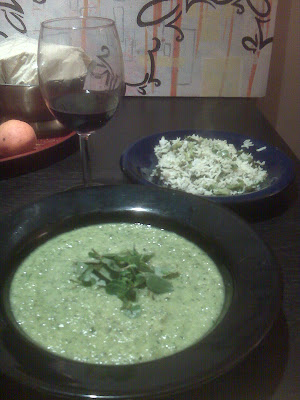
Herbed rice with fava beans and zucchini-purslane soup.
Our friend Tom came in from out of town last night (because he happens to like New York) and he kindly joined us for dinner. The rice dish was somewhat like a pilaf, but baked, so that the herbs infused the surrounding rice with flavor. It contained dill, parsley, cilantro, and garlic scapes (our substitute for scallions), and we threw in some chopped walnuts at the end for added texture. Lizz picked up local summer squash at the Morningside Heights greenmarket to supplement last week's haul.
For dessert, Lizz also picked up some local blueberries. We were so enchanted with our discovery of last night that we planned to use our last quarter-cup of cream to make whipped cream for a topping. We supplemented it with a little bit of milkfat from the top of a nonhomogenized bottle. However, as Tom graciously whisked the cream with a little sugar, the mixture didn't seem to be reaching the same hard peaks stage we had seen the previous night. And then, in just a couple of seconds, it suddenly turned into THIS:
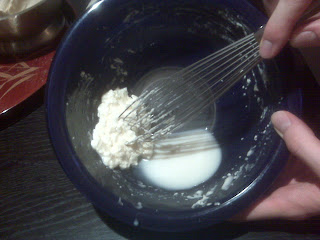
After we all got done exclaiming in shock and horror at the unexpected transformation, Lizz bravely took a taste, and suggested that perhaps we had just accidentally made butter. It seemed too good to be true that we would stumble on TWO different whipped dairy products within two days, but indeed, a little internet research confirmed that this actually IS how butter is made! If you continue whipping plain cream past the hard stage, it will in a matter of seconds fall out into butter and the thin buttermilk you see in the picture.
So we didn't have any whipped cream with our blueberries, but we were extremely pleased with the discovery nonetheless, and decided to incorporate it into the dessert in another way.

Blueberries with cinnamon toast....with homemade butter.
Labels:
basil,
blueberries,
dill,
fava beans,
purslane,
rice,
summer squash,
vegan,
walnut
Friday cat blogging
Thursday, July 23, 2009
Fool me once...fool me...you can't get fooled again!
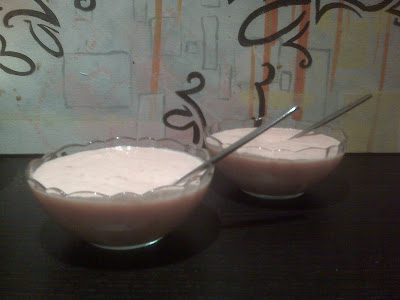
Redcurrant and yellow cherry fool.
A fool is (or so we have just learned) a classic British dessert, in which a fruit puree is mixed with some combination of sugar and cream/yogurt/egg whites. The recipe we followed called only for cream and yogurt, in addition to the fruit.
This was unbelievably good, in no small part because of the excellent cream (Ronnybrook Farm) and yogurt (Milk Thistle Farm) that we used. It really does make a difference.

red currants, pre-topping and tailing
As Giselle was beating the cream with some sugar, we were remarking in amazement at the increased volume and stiffness of the mixture. Then, it occurred to us that we were making the exotic substance known as "whipped cream." We are apparently still so alienated from the means of production that we did not realize what were making until we had made it.
Thursday: Spanish mackerel...plus leftovers

Broiled Spanish mackerel with leftover Tuscan kale and quinoa-millet-chickpea-squash salad (leftover from Monday's stuffed squash).
At this point, you may have noticed that we are not strictly vegetarians. We are what you might call "flexitarians," or maybe "pesca-flexitarians," or perhaps "flexitarian-locavores," or...well, why put a label on it?
Suffice it to say, we cook fish about once a week. This is supposedly quite good for you, if you can dodge the twin bullets of mercury and polychlorinated biphenyls (PCBs), but it's a struggle to eat fish responsibly. Many fish species are overfished, or farmed in environmentally devastating ways. Mark Bittman recently wrote a great column in the Times on this very subject.
We're trying to be more responsible about what fish we purchase, even though our options at local stores are pretty limited. This week we went for Spanish Mackerel, which is sustainably caught, but moderately high in mercury. The two leading resources for fish consumers are probably the Monterey Bay Aquarium's Seafood Watch (which focuses on environmental impact and sustainability) and Environmental Defense's Seafood Selector (which also includes information about health effects). We're going to try to follow their recommendations going forward, even if that means eating a little less fish.
Wednesday: Double-mustard potato salad

Double-mustard potato salad with tuscan kale.
We've both always had an irrational fear of potato salads. (Perhaps this had its origins in seeing the mayonnaise-drenched mush that appeared at midwestern picnics.) We recently decided to conquer our fears by finding a potato salad recipe we could respect. This one is easy: the potatoes are chopped and boiled for fifteen minutes, and then tossed with dijon mustard, grainy mustard, balsamic vinegar, olive oil, and basil. Weird, but it really works.
Tuesday, July 21, 2009
Tuesday: Spaghetti Nero di Seppia

Spaghetti nero di seppia (squid ink pasta) in a seafood cream sauce with baked treviso radicchio.
We've never made a cream sauce for pasta before, and ended up concluding the texture of this one was a bit too thin (should have started with a roux) but it was still delicious. The "seafood" was tinned octopus and cuttlefish.
Squid ink pasta is frequently made with the cuttlefish ink added directly to the sauce, but this spaghetti had been infused with the ink (thus the black color). You can also buy the actual cuttlefish ink in small packets....we have one in the pantry waiting for us to decide what to do with it.
Monday: Stuffed Squash
Sunday, July 19, 2009
Sunday light dinner

Tonight we were still recovering from our huge brunch of blueberry pancakes and scrambled eggs, so we went for a simple vegan dinner: green beans with walnut-miso sauce and soba (buckwheat) noodles, with another glass of homemade ginger ale.
And for dessert:

Local peaches (first of the year!) with a glass of Milk Thistle Farm milk.
Dinner party

Last night, we had a few friends over for dinner. (Not pictured: Richard.) In addition to the homemade ginger ale (see previous post), we made macaroni and cheese with a side of peas.

1 out of 1 Josephs agree - macaroni and cheese is delicious. (We used the local cheddar cheese from Hawthorne Valley Farm.)
To round out this very "American" dinner, we made a cherry cobbler with the pie cherries that we bought last week at the greenmarket:
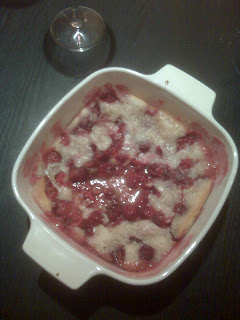
Yum.
Saturday, July 18, 2009
Homemade ginger ale

We're fans of homemade summer drinks: limeade, cherbat, iced green or plum tea, etc. Today we made our first real ginger ale. The commercial stuff that comes in two-liter bottles basically consists of high fructose corn syrup and water, and today contains NO actual ginger - only artificial flavoring from New Jersey. (No offense, New Jersey.) Ginger is legendary for its anti-nausea and stomach-soothing effects, which is probably why commercial ginger ale is still given to kids who are sick...except that stuff won't actually work.
Luckily it's extremely easy to make the real stuff. Here's the recipe we followed. I made a 1.5x recipe, which filled up a clean wine bottle.
HOMEMADE GINGER ALE
2 cups ginger root, chopped into about 1/4-1/2 inch pieces
3-4 strips lemon peel
1.5 cups sugar
4 cups water
Put ginger, lemon peel and water into a saucepan and bring to a boil; then simmer for ten minutes. Add sugar, bring to boil again and simmer fifteen minutes. It should reduce in volume to about three cups, and thicken a bit. Then strain the syrup, bottle, and store in fridge. To make a glass of the drink, mix 1/4 cup syrup with 1 cup soda water.
Here's how it looks as it's being strained:

And up top is the finished product along with a glass of the diluted drink, displayed in the window. It's very tasty - not as oversweet as the commercial kind, and with a strong ginger kick.
Saturday lunch

Usually on weekdays, lunch consists of leftovers from previous nights' dinners. But when we get back from the market on Saturday afternoons we often make a light meal out of something we need to use up or something that won't store well.
Today: a stir-fry of broccoli and tofu, flavored with garlic, ginger, and soy sauce; plus the leftover quinoa and summer squash dish. This local broccoli had lots of big, dark-green leaves, which we chopped up and tossed in. Broccoli leaves are apparently very nutritious, and we can vouch that they're tasty - they're flavorful and comparable to kale in texture.
Importing a tradition from the Simmons-Thrall household, this was followed by lunch dessert:

A fruit salad of local raspberries, blackberries and peaches.
Farmer's Market Haul, 7/18/09
We might have gone a little overboard on fruit this week:
VEGGIES:
green beans
red wax potatoes
fava beans
tuscan ("dinosaur") kale
cousa squash
"travesto" (maybe a mislabeling - we've seen it before called "treviso." It's a mottled, green and purple leafy variety of radicchio that grows loosely rather than in a head.)
purslane
basil
dill
garlic (rocambole)
onions
FRUIT:
raspberries (which actually made it all the way home this week)
blackberries
black cherries
peaches
small apricots
(also, due to a baking delay we've still got red currants, red gooseberries, sweet yellow cherries, and tart pie cherries in the fridge...but these are all destined for desserts.)
OTHER:
milk from Milk Thistle Farm
yogurt from Milk Thistle Farm
eggs
aged cheddar from Hawthorne Valley Farm
cornmeal from Oak Grove Plantation
Since we have a Manhattan-sized fridge (cf. title of this blog) it can be tough to fit everything in when we get back from the market. Here's how our fridge typically looks on Saturday afternoon:

Stay tuned for a comparison picture on Friday.
VEGGIES:
green beans
red wax potatoes
fava beans
tuscan ("dinosaur") kale
cousa squash
"travesto" (maybe a mislabeling - we've seen it before called "treviso." It's a mottled, green and purple leafy variety of radicchio that grows loosely rather than in a head.)
purslane
basil
dill
garlic (rocambole)
onions
FRUIT:
raspberries (which actually made it all the way home this week)
blackberries
black cherries
peaches
small apricots
(also, due to a baking delay we've still got red currants, red gooseberries, sweet yellow cherries, and tart pie cherries in the fridge...but these are all destined for desserts.)
OTHER:
milk from Milk Thistle Farm
yogurt from Milk Thistle Farm
eggs
aged cheddar from Hawthorne Valley Farm
cornmeal from Oak Grove Plantation
Since we have a Manhattan-sized fridge (cf. title of this blog) it can be tough to fit everything in when we get back from the market. Here's how our fridge typically looks on Saturday afternoon:

Stay tuned for a comparison picture on Friday.
Thursday, July 16, 2009
Thursday summer squash
Wednesday, July 15, 2009
Wednesday fish with sorrel
Monday, July 13, 2009
A simple Sunday dinner

Puntarelle in Salsa d'Acciughe (puntarella chicory salad with anchovy dressing) with Aged Bloomsday cheese and Kirby cucumber sandwich, accompanied by a glass of cherbat (Middle Eastern lemonade). Before any Italians out there write in to complain, this particular chicory is not truly puntarella, which is a specific varietal of Catalogna chicory. But it's close enough, and tastes delicious with the garlic-anchovy dressing.
New York Botanical Garden - The Edible Garden exhibit
Despite our love of fruits and vegetables, we have not spent much time around them in their native habitat since our abortive attempt at a fire escape herb garden last summer. So yesterday, we headed up to see the Edible Garden exhibit at the New York Botanical Garden. The exhibit features an elegantly landscaped outdoor garden full of heirloom plants (from the Seed Savers' Exchange collection) as well as a collection of tropical fruits and vegetables growing in the Botanical Garden's conservatory. And that is where we saw something that BLEW OUR MINDS:
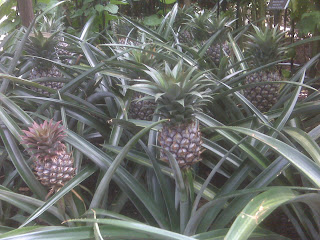
Yes, THAT IS ACTUALLY HOW PINEAPPLES GROW! They look like someone has stuck a pineapple onto a short pole and then jammed it into the ground at the center of a standard lily plant. Somehow, we had both figured that they must grow attached to the plant at the top - maybe in a tall palm tree of some kind. But apparently we were wrong.
We spotted some other familiar fixtures in our kitchen:

Amaranth - a purple variety, rather than the red-splashed green leaves we typically buy at the Indian grocery store. This type might be grown for its grain rather than its leaves, which can be used as vegetables.

It might be kind of hard to tell from the picture, but that green blob just above center is a smooth-skinned variety of avocado. It is growing hanging from a tree by a ridiculously thin stem. Who could blame us if it happened to fall into our outstretched hands......

This might be our favorite rhizome (and that is, actually, saying a lot) - if you look carefully at the tan patch at the bottom of this picture you will recognize the unmistakable shape of a piece of ginger! Those green bamboo-looking stems were growing straight up from the ginger "root" itself.

True addicts will recognize this as coffee. But only true addicts. (It's green because it is not ripe yet - later on it turns red, and then the coffee "bean" itself - actually a seed - is removed and roasted.)

Ok, this is not a vegetable, but a hipster panda would definitely like this bamboo. For some reason we found the stripes very aesthetically pleasing. Then we returned to the vegetables, and espied -

-some purple okra! It was growing on short, foot-tall plants. The leaves look like maple.

Sadly there were no melons to be seen, but this vine is the bitter melon plant - one of our favorite Indian grocery store purchases (and one of our favorite cucurbits).

This would have been more of a shock if we hadn't already learned (thanks, Wikipedia) about how cashews grow, but - that is a cashew fruit! The red part is actually sweet and is made into a drink in many countries. The weird kidney shape hanging off the bottom is the cashew, encased in a hard and very poisonous shell. Harvest has to be done carefully to keep the toxin from getting into the fruit juice.


Here, we have a chenopod family reunion: at top is our old friend quinoa, a useful South American staple whose seeds are treated as a grain. Apparently the leaves are also edible, but we don't get those around here. (If you are a farmers' market dork, you might notice that the leaves look a lot like lamb's quarters, an invasive weed around here that also happens to be a tasty and cheaper approximation of spinach.) At bottom is epazote, an herb which is a relative of quinoa and which is used sparingly in Mexican cooking to give refried beans and other dishes a distinctive flavor. The herb itself is more than distinctive - some people think it tastes like gasoline. You probably just have to get used to it. (Interestingly, epazote is also invasive in our region and apparently grows all over Central Park!)
After exploring the wonders of the greenhouse, we headed outside to see the lilies and lotuses growing in the conservatory's ponds:

(Gigantic lotus flower - Lizz for scale.) In addition to being a religious symbol, an extremely pretty flower, and a superhydrophobic nanostructured material, lotuses are a food! Their rhizomes, usually erroneously called lotus root, are weird tubular structures revealing a lacy pattern of holes when you slice them open. In the center of their flowers are these truly bizarre structures:

After pollination, the flower petals fall off leaving this seedpod (which looks like some kind of electrical plug). It slowly dries out, and the little dots expand to reveal dark lotus seeds, which can be ground into paste, mixed with sugar, and used in the pastries of several Asian countries.
On our way to the rose garden, we passed a tree that had dropped a million small, apricot-like fruits on the ground. Imagine our surprise when we looked at the tag and discovered it was:

PRUNUS MUME, OUR FAVORITE APRICOT! Ok, more specifically, it is the small fruit usually called a "plum" which is used to create Japanese umeboshi, a pink pickle flavored with shiso leaves (and much beloved by Giselle). They are also used to make Japanese plum wine. Despite much temptation, we resisted eating them out of hand.
Incidentally, just try saying "prunus mume" and not feeling happy.
We also encountered this innocent-looking vine:

Not much going on now, but this is the hops vine, known and loved by beer drinkers everywhere.
Last we visited the rose garden, now in full bloom:

Here is Lizz posing like a Greek statue amidst the flowers.

This is Giselle's favorite color of roses. But fear not, this DOES relate back to food (considering that this is a food blog):

What you see there are rose hips, the fruit of the rose bush! They are the expanded ovary of the pollinated rose flower, which grows like that after the petals have fallen off. These are used to make jellies and jams, and are sometimes candied. It might seem surprising that rose bushes make an edible fruit, but the family rosacea actually includes many well-known fruits, such as apples, cherries, and apricots - yes, including prunus mume.
Incredibly, we made it through the afternoon without illicitly harvesting any of these delicious fruits and vegetables, and returned home to cook dinner with our decontextualized ones.

Yes, THAT IS ACTUALLY HOW PINEAPPLES GROW! They look like someone has stuck a pineapple onto a short pole and then jammed it into the ground at the center of a standard lily plant. Somehow, we had both figured that they must grow attached to the plant at the top - maybe in a tall palm tree of some kind. But apparently we were wrong.
We spotted some other familiar fixtures in our kitchen:

Amaranth - a purple variety, rather than the red-splashed green leaves we typically buy at the Indian grocery store. This type might be grown for its grain rather than its leaves, which can be used as vegetables.

It might be kind of hard to tell from the picture, but that green blob just above center is a smooth-skinned variety of avocado. It is growing hanging from a tree by a ridiculously thin stem. Who could blame us if it happened to fall into our outstretched hands......

This might be our favorite rhizome (and that is, actually, saying a lot) - if you look carefully at the tan patch at the bottom of this picture you will recognize the unmistakable shape of a piece of ginger! Those green bamboo-looking stems were growing straight up from the ginger "root" itself.

True addicts will recognize this as coffee. But only true addicts. (It's green because it is not ripe yet - later on it turns red, and then the coffee "bean" itself - actually a seed - is removed and roasted.)

Ok, this is not a vegetable, but a hipster panda would definitely like this bamboo. For some reason we found the stripes very aesthetically pleasing. Then we returned to the vegetables, and espied -

-some purple okra! It was growing on short, foot-tall plants. The leaves look like maple.

Sadly there were no melons to be seen, but this vine is the bitter melon plant - one of our favorite Indian grocery store purchases (and one of our favorite cucurbits).

This would have been more of a shock if we hadn't already learned (thanks, Wikipedia) about how cashews grow, but - that is a cashew fruit! The red part is actually sweet and is made into a drink in many countries. The weird kidney shape hanging off the bottom is the cashew, encased in a hard and very poisonous shell. Harvest has to be done carefully to keep the toxin from getting into the fruit juice.


Here, we have a chenopod family reunion: at top is our old friend quinoa, a useful South American staple whose seeds are treated as a grain. Apparently the leaves are also edible, but we don't get those around here. (If you are a farmers' market dork, you might notice that the leaves look a lot like lamb's quarters, an invasive weed around here that also happens to be a tasty and cheaper approximation of spinach.) At bottom is epazote, an herb which is a relative of quinoa and which is used sparingly in Mexican cooking to give refried beans and other dishes a distinctive flavor. The herb itself is more than distinctive - some people think it tastes like gasoline. You probably just have to get used to it. (Interestingly, epazote is also invasive in our region and apparently grows all over Central Park!)
After exploring the wonders of the greenhouse, we headed outside to see the lilies and lotuses growing in the conservatory's ponds:

(Gigantic lotus flower - Lizz for scale.) In addition to being a religious symbol, an extremely pretty flower, and a superhydrophobic nanostructured material, lotuses are a food! Their rhizomes, usually erroneously called lotus root, are weird tubular structures revealing a lacy pattern of holes when you slice them open. In the center of their flowers are these truly bizarre structures:

After pollination, the flower petals fall off leaving this seedpod (which looks like some kind of electrical plug). It slowly dries out, and the little dots expand to reveal dark lotus seeds, which can be ground into paste, mixed with sugar, and used in the pastries of several Asian countries.
On our way to the rose garden, we passed a tree that had dropped a million small, apricot-like fruits on the ground. Imagine our surprise when we looked at the tag and discovered it was:

PRUNUS MUME, OUR FAVORITE APRICOT! Ok, more specifically, it is the small fruit usually called a "plum" which is used to create Japanese umeboshi, a pink pickle flavored with shiso leaves (and much beloved by Giselle). They are also used to make Japanese plum wine. Despite much temptation, we resisted eating them out of hand.
Incidentally, just try saying "prunus mume" and not feeling happy.
We also encountered this innocent-looking vine:

Not much going on now, but this is the hops vine, known and loved by beer drinkers everywhere.
Last we visited the rose garden, now in full bloom:

Here is Lizz posing like a Greek statue amidst the flowers.

This is Giselle's favorite color of roses. But fear not, this DOES relate back to food (considering that this is a food blog):

What you see there are rose hips, the fruit of the rose bush! They are the expanded ovary of the pollinated rose flower, which grows like that after the petals have fallen off. These are used to make jellies and jams, and are sometimes candied. It might seem surprising that rose bushes make an edible fruit, but the family rosacea actually includes many well-known fruits, such as apples, cherries, and apricots - yes, including prunus mume.
Incredibly, we made it through the afternoon without illicitly harvesting any of these delicious fruits and vegetables, and returned home to cook dinner with our decontextualized ones.
Subscribe to:
Posts (Atom)









